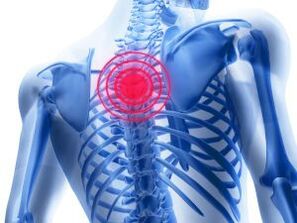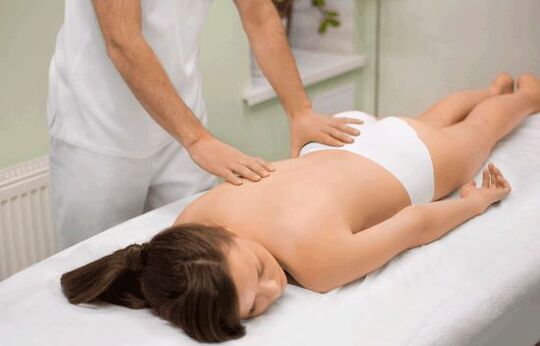
Clinically, thoracic osteochondrosis (chondrosis) is manifested by acute, penetrating or dull, aching pains, crunching and clicking when flexed, stiffness.
For pathology, features and numerous specific symptoms are a feeling of shortness of breath when inhaling, discomfort in the heart area and even a sore throat.
The treatment of the pathology is mainly conservative with pharmacological drugs. Physiotherapy procedures, massage sessions and chiropractors are also performed.
If such treatment is ineffective, surgery is indicated for the patient.
Details of the symptoms
The symptoms of osteochondrosis of the thoracic spine never appear at the same time. In the early stages of the development of this degenerative-dystrophic pathology, there is only mild back discomfort. Patients take them for typical fatigue after a hard day's work, they delete the muscles "numb" due to long stay in one place of the body.
But the intensity of the suffering is increasing slowly, steadily. Unpleasant sensations are replaced by severe pain, complicated by limited range of motion, dizziness and headaches. In medicine, all the symptoms of osteochondrosis of a given localization are divided into different groups. This helps in faster diagnosis and determines treatment tactics.
On a note!The symptoms of thoracic osteochondrosis in men and women do not differ in character, severity or location. But in the stronger sex, they may appear a little later due to the stronger musculoskeletal system. Also, some men have erectile dysfunction in the context of osteochondrosis.
Spinal symptoms
Under the influence of adverse factors (hypothermia, increased physical activity), the long-term remission of osteochondrosis in the chest can be interrupted by a sudden onset of acute pain. Even more often, it is caused by a long stay in one position of the body, for example, in a sitting position. If a person gets up abruptly, then there is so much back pain that he loses the ability to move for several minutes.
In medicine, this condition is called dorsago. It differs from the usual pain in simultaneous symptoms:
- shortness of breath.
- severe stiffness.
The course of the pathology is often complicated by back pain - chest pain, the intensity of which gradually increases. It increases with the bending, turning the body sideways. In order not to experience pain, a person takes a forced position. At the same time, it inadvertently strains the back muscles, inadvertently causing them to over-stretch. Now they also start to hurt, especially when you walk.
Extravertebral symptoms
As thoracic osteochondrosis develops, the intervertebral discs become thinner and damaged. These cartilaginous patches can no longer distribute the resulting loads, they exclude the collision of the vertebrae with each other. It causes a compensatory response of the body - the bone structures begin to deform with the formation of growths. They press on the sensitive nerve endings, affecting the spinal canal. Therefore, there are specific symptoms of thoracic osteochondrosis in women and men: loss of sensitivity in certain parts of the body, burning sensation and creeping "goose bumps".
Great! Osteochondrosis of the thoracic localization is often manifested by dry, unproductive cough, sore throat, coma in it, as well as disorders of the urinary system.
But that is not all. The roots of the spine are responsible not only for the nerve (transmission of nerve impulses) of the spine, but also for the internal organs. Therefore, when violated, there are unpleasant sensations from the liver, kidneys, digestive tract, myocardium. What are the signs that are not typical for back pathologies manifested by thoracic osteochondrosis:
- pain in the heart area, identical to the recurrence of angina, shortness of breath, feeling of "compression" of the heart.
- panic attacks, psycho-emotional instability, irrational fear, anxiety, sleep disorders.
- discomfort in the epigastric region, nausea attacks, which sometimes lead to vomiting, sour belching, bloating, effervescence and thunder in it.
- peristaltic disorders - constipation or diarrhea.
- prolonged, tired breaths with sobs.
The pain is not located directly at the site of the damaged intervertebral disc and (or) the formed intervertebral hernia. They radiate in the course of the nerve. Signs of osteochondrosis of the thoracic region can be disguised as renal colic, symptoms of gastritis, gastric ulcer, hepatitis, pancreatitis, cholecystitis, and even gastroenteritis.
Compression myelopathy
This is the name of the extravertebral syndrome, which is rarely seen in clinical practice. It is observed in 3-4 stages of the disease, when, due to the loss of stability from the vertebral part, the nucleus of the nucleus protrudes beyond the fibrous ring. An intervertebral hernia forms, which constantly presses on the spinal cord. At an appointment with a vertebrate or neurologist, patients complain of frequent pain in the area that radiates to the groin area. At the same time, there are feelings of weakness, numbness of the lower extremities.
In the context of spinal cord injury, the nerve is severely disrupted. In the absence of treatment, the functional activity of the organs located in the small pelvis is reduced. Compression myelopathy causes problems with bowel movements. And due to the intense narrowing of the diameter of the spinal canal, the sensitivity of the legs decreases. In severe cases, patients are diagnosed with paralysis (partial or complete paralysis) of one or both lower limbs.
Symptoms of recession
Except for relapses, breast osteochondrosis hardly bothers a person. Occasionally, there is a dull, aching, dull back pain, which usually disappears after a long rest. But it is worth at least slightly increasing the load on the spine, lifting a heavy object or bending over, as follows the next relapse. It can be caused by such factors:
- stressful situations, depressive situations.
- hypothermia, sudden temperature changes.
- prolonged stay in one position of the body.
- alcohol abuse?
- unbalanced diet, lack of foods high in calcium, phosphorus, manganese, molybdenum in the diet.
Sometimes the recession stage ends because one person is trying to avoid another relapse. Visits a chiropractor or massage therapist with a dubious reputation or little practical experience. An attempt to stretch the spine leads to another flare-up.
The main methods of treatment
It is not yet possible to completely cure the pathology, so all the efforts of doctors are aimed at improving the well-being of the patient. Patients are advised to wear orthopedic products (corsets, bandages), which fasten the vertebral structures, preventing their displacement. Drugs of various clinical and pharmacological groups are prescribed, physiotherapy measures and physiotherapy exercises are performed.

The movements of the chiropractor's hands aim to increase the gaps between the vertebrae, which are reduced in osteochondrosis of the chest.
Great!With severe osteochondrosis of the chest, conservative treatment is useless. Patients are offered immediate surgery - resection of the intervertebral hernia, arthrodesis, placement of implants in place of a damaged disc, bone graft.
Medication
The treatment of osteochondrosis of the thoracic spine aims to eliminate all symptoms, to inhibit destructive and degenerative processes. In periods of exacerbation, solutions for parenteral administration are used, which show results after 5-10 minutes. The result is then consolidated by taking a course of tablet preparations, applying ointments and gels. In the recession stage, mainly external factors are used, which have a milder effect on the body.
Non-steroidal anti-inflammatory drugs (NSAIDs)
This is the most commonly used group of drugs in the complex treatment of thoracic osteochondrosis. Their active ingredients inhibit the biosynthesis of arachidonic acid mediators of pain, inflammation and fever. Even after one use of NSAIDs, a person's well-being improves significantly:
- the severity of the pain syndrome decreases.
- the unpleasant crisis that occurs when the body turns and tilts disappears.
- Inflammatory processes in the soft tissues weaken, the swelling subsides.
- the range of motion in the chest area increases.
Intramuscular solutions are used to stop relapses. Preparations in capsules or tablets can treat moderate pain. Both ointments and gels quickly eliminate mild discomfort.
Preparations with B vitamins
Preparations with B vitamins treat neurological disorders well. They improve the transmission of nerve impulses to the central and peripheral nervous system, stimulate the repair of damaged roots of the spine. The composition of the funds is represented by thiamine, riboflavin, pyridoxine, cyanocobalamin.
In the first week of treatment, intramuscular administration of drugs is exercised, which, in addition to vitamins, contain lidocaine, which immediately eliminates the pain. And then, for a month, patients show up taking pills.
Glucocorticosteroids
The use of these synthetic analogues of hormones, produced by the adrenal glands, is applied when the safest means are ineffective. Glucocorticosteroids are prescribed to patients with acute, penetrating back pain that radiates to internal organs. Medications can be taken orally, but are much more commonly administered parenterally, even in areas of damaged discs.
Glucocorticosteroids have a wide range of contraindications and possible side effects. Long-term treatment of thoracic spine cartilage with hormones leads to damage to the tissues of the liver, kidneys and stomach. Thus their use is prohibited in patients with cirrhosis, peptic ulcer, renal failure and osteoporosis.
Muscle relaxants
Back pain is often attributed to increased skeletal muscle tone. To relax, muscle relaxants are used - first in the form of solutions for parenteral administration and then in tablets. The drugs relieve the muscle spasm that causes compression of the root spine. Which muscle relaxants are most effective:
- exclusion of polysynaptic reflexes.
- relaxing spasmodic muscles.
- reducing prostaglandin release.
Monotherapy drugs are rarely used. The treatment of chest cartilage is performed with muscle relaxants in combination with glucocorticosteroids or non-steroidal anti-inflammatory drugs. Their main disadvantage is the rather fast formation of addiction, so their use is prohibited for more than a week.
Chondroprotective
Unlike drugs that eliminate the symptoms of osteochondrosis in the breast, such drugs are also used for pathogenetic treatment. This is the only group of drugs that can increase the production of chondrocytes, which are necessary for the partial repair of cartilaginous intervertebral discs. All the therapeutic effects of chondroprotectants are due to the high content of glucosamine and / or chondroitin.
But not only for the ability to restore discs, chondroprotectors are valued. Their ingredients shine in the area of the damaged spine. After 2-3 weeks, the maximum therapeutic concentration of glucosamine and chondroitin is created. Now the drugs have begun to show a strong analgesic, anti-inflammatory, anti-edematous effect.
Recommendation!Treatment of osteochondrosis with chondroprotectants in the form of injection solutions or tablets is recommended. Despite the manufacturers' assurances about the effectiveness of the ointments and creams, they were unable to provide any documentation of their therapeutic efficacy.
Non-medication
Treatment of thoracic osteochondrosis with medication must necessarily be combined with regular physical therapy. Exercise therapy is the most effective treatment method for preventing disability. Thanks to daily training, the muscular framework of the back is strengthened and the connection of the tendons of the chest area is improved, the production of synovial fluid that nourishes the vertebral structures is improved. The set of exercises is determined by the exercise doctor after studying the results of the diagnostic X-rays. He is present in the first classes, he monitors the dosage of the loads.
Manual treatment of osteochondrosis is also applied, with the aim of increasing the gaps between the discs and the vertebrae. It is made dry or underwater traction (traction) of the spine and at home - hangs on the bar. The effectiveness of manual therapy increases with the simultaneous conduct of physiotherapy:
- electrophoresis;
- laser treatment;
- magnetotherapy;
- ultraviolet radiation;
- diadynamic currents.
Patients show 10-15 sessions of classic, vacuum, Scandinavian, acupuncture. Also useful are irudotherapy, acupuncture, spa treatment with radon and hydrogen sulfide baths.
Only with the help of an integrated approach in the treatment of thoracic osteochondrosis is it possible to exclude further damage to the discs and deformity of the vertebrae. Adherence to the doctor's recommendations helps to get rid of all the symptoms of chronic pathology as soon as possible.












































